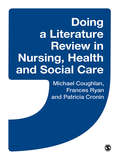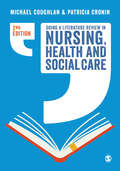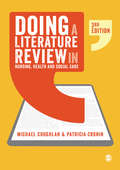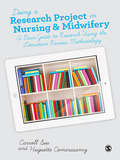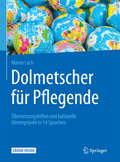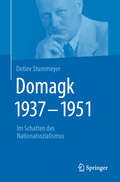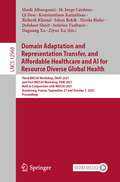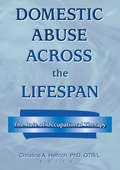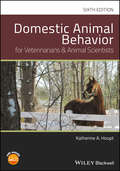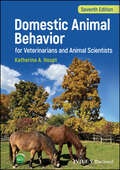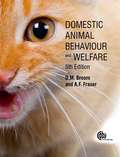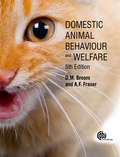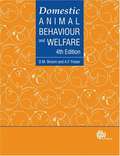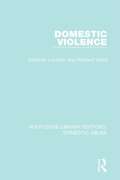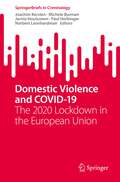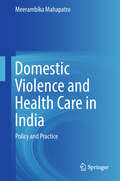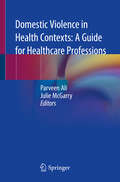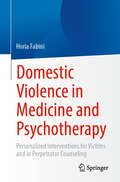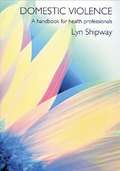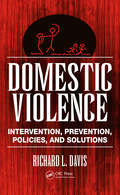- Table View
- List View
Doing a Literature Review in Nursing, Health and Social Care
by Michael Coughlan Dr Patricia Cronin Frances RyanHow do I start my literature review? What sources can I go to for information? How do I analyse the work of others? This clear, practical book guides readers undertaking their own literature review through the process, giving them the skills and knowledge they need for success. The chapters address: - Different types of literature reviews - Critically analysing material - Presenting the final piece of work - Best practice in referencing and plagiarism - Systematic approaches to literature reviews A wide range of examples from books, journals and other sources are included to demonstrate the process in action. Each chapter also includes activities and checklists to help readers develop their own work. It will be an essential guide for all nursing and all allied healthcare students, as well as professionals working in practice.
Doing a Literature Review in Nursing, Health and Social Care
by Michael Coughlan Patricia CroninHow do I start my literature review? What sources can I go to for information? How do I analyse the work of others? This clear, practical book guides readers undertaking their own literature review through the process, giving them the skills and knowledge they need for success. The chapters address: - Different types of literature reviews - Critically analysing material - Presenting the final piece of work - Best practice in referencing and plagiarism - Systematic approaches to literature reviews It will be an essential guide for all nursing and all allied healthcare students, as well as professionals working in practice.
Doing a Literature Review in Nursing, Health and Social Care
by Michael Coughlan Patricia CroninHow do I start my literature review? What sources can I go to for information? How do I analyse the work of others? This clear, practical book guides readers undertaking their own literature review through the process, giving them the skills and knowledge they need for success. The chapters address: - Different types of literature reviews - Critically analysing material - Presenting the final piece of work - Best practice in referencing and plagiarism - Systematic approaches to literature reviews It will be an essential guide for all nursing and all allied healthcare students, as well as professionals working in practice.
Doing a Literature Review in Nursing, Health and Social Care
by Michael Coughlan Patricia CroninA clear and practical guide to completing a literature review in nursing and healthcare studies. Providing you with straightforward guidance on how to successfully carry out a literature review as part of your research project or dissertation, this book uses examples and activities to demonstrate how to complete each step correctly, from start to finish, and highlights how to avoid common mistakes. Perfect for any nursing or healthcare student new to literature reviews and for anyone who needs a refresher on this important topic. The third edition includes: Expert advice on selecting and researching a topic A chapter outlining the different types of literature review you may come across Increased focus on Critical Appraisal Tools and how to use them effectively New real-world examples presenting best practice Instructions on writing up and presenting the final piece of work
Doing a Literature Review in Nursing, Health and Social Care
by Michael Coughlan Patricia CroninA clear and practical guide to completing a literature review in nursing and healthcare studies. Providing you with straightforward guidance on how to successfully carry out a literature review as part of your research project or dissertation, this book uses examples and activities to demonstrate how to complete each step correctly, from start to finish, and highlights how to avoid common mistakes. Perfect for any nursing or healthcare student new to literature reviews and for anyone who needs a refresher on this important topic. The third edition includes: Expert advice on selecting and researching a topic A chapter outlining the different types of literature review you may come across Increased focus on Critical Appraisal Tools and how to use them effectively New real-world examples presenting best practice Instructions on writing up and presenting the final piece of work
Doing a Research Project in Nursing and Midwifery: A Basic Guide to Research Using the Literature Review Methodology
by Huguette Comerasamy Carroll SiuDue to ethical issues surrounding data collection in the field of healthcare, students are no longer able to undertake their own empirical research. This book is written for nursing and midwifery students completing a research project based on reviewing published literature and using secondary data. It de-mystifies the concept of literature review methodology and supports students writing up their dissertation, thesis or work-based learning project. The book provides step-by-step guidance on: - Identifying a research problem - Qualitative and quantitative research design - Literature searching - Ethical considerations - Analysis of secondary data - Writing your dissertation Through its discussion of non-empirical methods, the book also prepares students for future empirical research by providing examples of best practice in healthcare research. The book is essential reading for undergraduates and postgraduates who want to succeed in their nursing or midwifery research project.
Dolmetscher für Pflegende: Übersetzungshilfen und kulturelle Hintergründe in 14 Sprachen
by Maren LachDieses Buch bietet Mitarbeitern aus dem Bereich Pflege sofortige Hilfe und Unterstützung bei der Kommunikation mit ausländischen Patienten und Flüchtlingen.Sprachliche und kulturelle Barrieren behindern oft eine vertrauensvolle Betreuung von Menschen mit Migrationshintergrund. Sie erschweren tägliche Pflegeprozesse wie Patientenanamnesen, Symptombehandlungen oder die Körperpflege. Die enthaltenen Übersetzungstabellen und kulturellen Hintergrundinformationen helfen diese Hindernisse im Praxisalltag zu überwinden. Jedes Kapitel umfasst eine Landessprache und erklärt die Besonderheiten der entsprechenden Lebensweise. So schaffen Sie eine vertrauensvolle Basis für ein respektvollen Umgang mit den Patienten und deren Angehörigen. div>
Dolphin Healing: The extraordinary power and magic of dolphins to heal and transform our lives
by Horace E. DobbsInternationally renowned dolphin expert Dr Horace Dobbs tells the incredible story of over two decades' work with dolphins and reveals new research that shows how dolphins can inspire us not only with their beauty and intelligence; they can also heal us physically and emotionally. Dobbs explores possible scientific explanations for the healing power of dolphins which he supports with many heart-warming tales of personal transformation. These stories include that of Bill who, after swimming with dolphins, was completely cured after 12 years of depression; Lilo who's terminal cancer regressed; and the incredible story of Eve, a severely autistic girl who uttered her first word, 'good', after meeting a dolphin. The book also examines the success of organised dolphin healing around the world including the work of the famous Dolphin Healing Centre in Kyoto, Japan. Inspiring and deeply moving, Dolphin Healing heralds a breathtaking new development in communications between humans and dolphins.
Domagk 1937-1951: Im Schatten des Nationalsozialismus
by Detlev StummeyerDomagk ist bisher als Forscher beschrieben, der völlig unbeeinflusst vom Nationalsozialismus geblieben ist. Dies war nur möglich, indem die Zeit des Nationalsozialismus ausgeblendet wurde. Darunter fallen auch seine Verdienste als Tuberkuloseforscher; nur unvollständig sind sie nach dem Krieg rezipiert worden. Sie hätten Domagks Eingebundenheit in das NS-System offenbart. Diese bleibt deshalb so unbekannt, weil seine Gestapo-Haftzeit ihn immun gegen kritisches Nachfragen machte. Auf Anordnung Hitlers wurde er im Zuge der Nobelpreisehrung für dreieinhalb Tage inhaftiert, was entgegen vorliegender Dokumente als Beweis seiner oppositionellen Haltung interpretiert wird. Seine von ihm Anfang der 1960er Jahre verfassten Lebenserinnerungen, in denen er sich durchaus als Hitlersympathisant zu erkennen gibt, werden ab 1990 zu einem authentischen Tagebuch umgedeutet, mit dessen Hilfe Domagks angeblich kritische Haltung im 3. Reich bewiesen werden soll. Ebenso kommt das Schicksal seines frühen Mitstreiters Paul Bosse und dessen Sulfonamidbuch von 1943 zur Sprache. Beide, Domagk und Bosse, setzten sich schon früh für die Behandlung von Kriegswunden mit Sulfonamiden ein.
Domain Adaptation and Representation Transfer and Medical Image Learning with Less Labels and Imperfect Data: First MICCAI Workshop, DART 2019, and First International Workshop, MIL3ID 2019, Shenzhen, Held in Conjunction with MICCAI 2019, Shenzhen, China, October 13 and 17, 2019, Proceedings (Lecture Notes in Computer Science #11795)
by Qian Wang M. Jorge Cardoso Shadi Albarqouni Steve Jiang Fausto Milletari Hien V. Nguyen Nicola Rieke Ziyue Xu Konstantinos Kamnitsas Vishal Patel Badri Roysam Kevin Zhou Khoa Luu Ngan LeThis book constitutes the refereed proceedings of the First MICCAI Workshop on Domain Adaptation and Representation Transfer, DART 2019, and the First International Workshop on Medical Image Learning with Less Labels and Imperfect Data, MIL3ID 2019, held in conjunction with MICCAI 2019, in Shenzhen, China, in October 2019. DART 2019 accepted 12 papers for publication out of 18 submissions. The papers deal with methodological advancements and ideas that can improve the applicability of machine learning and deep learning approaches to clinical settings by making them robust and consistent across different domains. MIL3ID accepted 16 papers out of 43 submissions for publication, dealing with best practices in medical image learning with label scarcity and data imperfection.
Domain Adaptation and Representation Transfer, and Affordable Healthcare and AI for Resource Diverse Global Health: Third MICCAI Workshop, DART 2021, and First MICCAI Workshop, FAIR 2021, Held in Conjunction with MICCAI 2021, Strasbourg, France, September 27 and October 1, 2021, Proceedings (Lecture Notes in Computer Science #12968)
by M. Jorge Cardoso Shadi Albarqouni Islem Rekik Nicola Rieke Ziyue Xu Konstantinos Kamnitsas Daguang Xu Qi Dou Bishesh Khanal Debdoot Sheet Sotirios TsaftarisThis book constitutes the refereed proceedings of the Third MICCAI Workshop on Domain Adaptation and Representation Transfer, DART 2021, and the First MICCAI Workshop on Affordable Healthcare and AI for Resource Diverse Global Health, FAIR 2021, held in conjunction with MICCAI 2021, in September/October 2021. The workshops were planned to take place in Strasbourg, France, but were held virtually due to the COVID-19 pandemic.DART 2021 accepted 13 papers from the 21 submissions received. The workshop aims at creating a discussion forum to compare, evaluate, and discuss methodological advancements and ideas that can improve the applicability of machine learning (ML)/deep learning (DL) approaches to clinical setting by making them robust and consistent across different domains. For FAIR 2021, 10 papers from 17 submissions were accepted for publication. They focus on Image-to-Image Translation particularly for low-dose or low-resolution settings; Model Compactness and Compression; Domain Adaptation and Transfer Learning; Active, Continual and Meta-Learning.
Domestic Abuse Across the Lifespan: The Role of Occupational Therapy
by Christine HelfrichDomestic abuse has reached epidemic proportions in the United States. Are you prepared to work with the people whose lives it has changed?Domestic Abuse Across the Lifespan: The Role of Occupational Therapy reframes the problem of domestic violence, taking it out of the home and into the practice of occupational therapy. It identifies the effects of all types of domestic abuse (spousal, child, elder, etc.) as well as frameworks to address dysfunction that has occurred secondary to the abuse. This book shows that the effects of domestic abuse are indeed in the realm of occupational therapy practice, and that just as occupational therapists would consider other environmental concerns (i.e. kitchen and bathroom safety), they must also consider abuse and its effects.Domestic Abuse Across the Lifespan: The Role of Occupational Therapy provides you with: definitions and illustrative examples of each type of domestic violence risk factors for becoming a victim or an abuser an examination of the occupational therapist's role with victims of abuse reasons why women may decide to refuse intervention a discussion of the connection between victim advocacy and occupational therapy a case study detailing the clinical findings and treatment of a six-month-old infant with shaken baby syndrome who received in-patient occupational therapy a case study of a child witness of domestic abuse and the use of the Occupational Therapy Psychosocial Assessment of Learning (OT PAL) in measuring the psychosocial aspects of his performance in a nontraditional classroom setting a checklist for occupational therapists who encounter elder abuse and a case study that illustrates its use . . . and much more!The number of people whose lives are scarred by domestic abuse is vast and growing every day. Occupational therapists working in many different settings will encounter children, adults, elders, and individuals with disabilities who have experienced intimate violence and abuse. Domestic Abuse Across the Lifespan: The Role of Occupational Therapy is the tool to help you help them.
Domestic Animal Behavior for Veterinarians and Animal Scientists
by Katherine A. HouptDomestic Animal Behavior for Veterinarians and Animal Scientists, Sixth Edition is a fully updated revision of this popular, classic text offering a thorough understanding of the normal behavior of domestic animals. Provides a complete understanding of the normal behavior of domestic animals Covers dogs, cats, horses, pigs, sheep, cattle, and goats Describes all key aspects of animal behavior, with images to support the concepts Revised and updated to cover the latest thinking, with enhanced coverage of behavioral genetics, animal cognition, and learning Includes access to a companion website with review questions and answers and the figures from the book in PowerPoint
Domestic Animal Behavior for Veterinarians and Animal Scientists
by Katherine A. HouptFully updated revision of a classic text offering a thorough understanding of the normal behavior of domestic animals The Seventh Edition of Domestic Animal Behavior for Veterinarians and Animal Scientists is a fully updated revision of this popular, classic text offering a thorough understanding of the normal behavior of domestic animals. Maintaining the foundation of earlier editions, chapters examine key behavior issues ranging from communication to social structure. The Seventh Edition adds enhanced coverage of behavioral genetics, animal cognition, and learning, considering new knowledge and the very latest information throughout. Each chapter covers a wide variety of farm and companion animals, including dogs, cats, horses, pigs, sheep, cattle, and goats. Major additions are chicken and donkey behavior as well as the microbiome. Each chapter covers a particular behavior subdivided by species. The information has been updated using information published in the past five years. To aid in reader comprehension and assist in self-learning, a companion website provides review questions and answers and the figures from the book in PowerPoint. Sample topics covered in Domestic Animal Behavior for Veterinarians and Animal Scientists include: Communication patterns, perception, vocalization, visual signals, social behavior, sleep and activity patterns, and detection of emotions in others Maternal behavior, pain- and fear-induced aggression, feeding habits, and behavioral problems (such as cribbing, offspring rejection and anxiety) Aggression and social structure, stereotypic behavior, free-ranging versus confined behavior, and maternal behavior (such as recognizing the young) Sexual behavior, development of behavior, and sleep behavior, including ultradian, circadian, annual, and other rhythms Ingestive behavior (food and water intake), hyperactivity and narcolepsy, and overall learning behavior The role of genetics, the environment, and the microbiome in behavior The Seventh Edition of Domestic Animal Behavior for Veterinarians and Animal Scientists is an essential reference for students of animal science and veterinary students, as well as qualified veterinarians and animal scientists seeking a more thorough understanding of the principles of animal behavior.
Domestic Animal Behaviour and Welfare
by Donald Broom Andrew FraserHumans have a natural interest in animals; through a long history of domestication, they have become tools, a food source and even friends. Behaviour is a significant indicator of animal health and well-being, and understanding this behaviour is therefore the key to good management. Covering all aspects of animal behaviour and how this relates to welfare for companion animals, farm animals and farmed fish, this book reviews development, socialisation, locomotion, reproduction and more. It takes a comprehensive approach to the subject, including a section of chapters addressing common abnormal behaviours and reviewing some animals, such as rabbits, from both a pet and farm perspective. Now in its fifth edition, Domestic Animal Behaviour and Welfare includes new chapters detailing the welfare of sheep, goats and exotic pets, and welfare in relation to genetic selection and modification. Animal behaviour and welfare sciences are now core topics for agriculture and veterinary students, with courses and research opportunities in this field growing world-wide. Fully updated and with new photographs, this indispensable textbook provides a student-friendly guide to the major themes of animal behaviour and welfare.
Domestic Animal Behaviour and Welfare
by Donald Broom Andrew FraserHumans have a natural interest in animals; through a long history of domestication, they have become tools, a food source and even friends. Behaviour is a significant indicator of animal health and well-being, and understanding this behaviour is therefore the key to good management. Covering all aspects of animal behaviour and how this relates to welfare for companion animals, farm animals and farmed fish, this book reviews development, socialisation, locomotion, reproduction and more. It takes a comprehensive approach to the subject, including a section of chapters addressing common abnormal behaviours and reviewing some animals, such as rabbits, from both a pet and farm perspective. Now in its fifth edition, Domestic Animal Behaviour and Welfare includes new chapters detailing the welfare of sheep, goats and exotic pets, and welfare in relation to genetic selection and modification. Animal behaviour and welfare sciences are now core topics for agriculture and veterinary students, with courses and research opportunities in this field growing world-wide. Fully updated and with new photographs, this indispensable textbook provides a student-friendly guide to the major themes of animal behaviour and welfare.
Domestic Animal Behaviour and Welfare, 4th edition
by Donald Broom Andrew FraserBehaviour is a significant indicator of health in animals and understanding behaviour is the key to good management. Animal behaviour and animal welfare science are fast becoming core topics in the curriclua of agriculture and veterinary students. The eagerly awaited fourth edition of Farm Animal Behaviour and Welfare builds on the coverage of the previous edition, fully updating it to take into account developments over the last 10 years. This new edition covers companion animals as well as farm animal species including farmed fish. It is an indispensible textbook covering the major and growing areas in agricultural and veterinary science and practice.
Domestic Violence (Routledge Library Editions: Domestic Abuse #5)
by Deborah Lockton Richard WardFirst published in 1997, this book marks a culmination of a three year research programme focused upon the incidence of domestic violence in Leicester. The study examined the levels of violence, the details of applicants and respondents and the nature of complaints, as well as the policies applied and the problems faced by those enforcing the law. The books sets the findings in the context of the policies on protection of victims of domestic violence, the problems they face and protection after 1997. This book will be of interest to those studying law, social work, sociology and women’s studies.
Domestic Violence and COVID-19: The 2020 Lockdown in the European Union (SpringerBriefs in Criminology)
by Jarmo Houtsonen Joachim Kersten Michele Burman Paul Herbinger Norbert LeonhardmairThis brief maps the available data augmented by expert interviews on the impact of the Covid-19 measures on DV in eight European Member States during the first lock-down. The volume addresses an on-going situation, additionally complicated by renewed lockdown restrictions during autumn and early winter 2020. It assesses the assumptions of an imminent wave of domestic violence against reliable data from crime statistics, surveys, and various institutions responding to domestic violence. Collecting partner country reports from Austria, Finland, France, Germany, Hungary, Portugal, Scotland and Slovenia, it demonstrates the effects that lockdown measures starting March 2020 had on reported DV incidents. It considers the differences between each country with respect to policing, legal systems, social and cultural factors and highlights best practices to prevent conditions resulting from Covid-19 lockdown undermining victims’ security and frontline responders’ capacities to provide services and prevent domestic violence.
Domestic Violence and Health Care in India: Policy And Practice
by Meerambika MahapatroThis book discusses health care issues related to domestic violence, using extensive case studies from India. By discussing the global literature, legal systems, methodological challenges of gathering information on domestic violence, and health systems issues, along with learnings from case studies, it fills a significant gap in the literature between health care policy and practice vis-à-vis victims of domestic violence. It therefore enables a systemic and systematic response to incidents of domestic violence. Policy instructions, court verdicts, government interventions, community-based direct interventions and related case discussions in the book help in the understanding and management of cases. Though the book uses case studies from India, it addresses globally relevant issues for health care professionals. In view of the paucity of application of systematic evidence-based knowledge, the holistic perspective presented in the book is important to prevent domestic violence, protect women’s rights, and promote healthcare and wellbeing of women and children facing domestic violence. Medical professionals are expected to intervene in instances of injuries related to domestic violence---a responsibility that they are currently unable to fulfil due to lack of training in recognizing abuse and lack of tools for intervention. This book improves hands-on-knowledge by providing information on where to refer victims for assistance and timely intervention. Comprehensive yet lucid, this book is useful for academics, policy makers, non-government organizations and women’s rights groups in helping victims during and after a violent episode and also in improving reporting and referral services.
Domestic Violence in Health Contexts: A Guide for Healthcare Professions
by Parveen Ali Julie McGarryThis book is taking a broad health focused approach towards Domestic Violence and Abuse (DVA). It is now well established that DVA exerts a significant and detrimental impact on the health and wellbeing of those who experience abuse. Universally healthcare professionals encounter individuals and families where DVA is or has taken place. This book is beneficial to a range of health care professionals through an exploration of theories and classifications of DVA, consideration of DVA in different contexts and consideration of the core issues surrounding working with individuals and families where DVAhas been identified. It provides a much needed evidence based addition to the existing texts in this field in terms of the inclusion of real life scenarios, reflective exercises and pointers for further practice development. This book is a key point of reference for professionals working within a broad range of health care environments.
Domestic Violence in Medicine and Psychotherapy: Personalized Interventions for Victims and in Perpetrator Counseling
by Horia FabiniThis specialist book provides essential insights for professionals: Domestic violence is not a mental disorder—it is a threatening scenario that entails significant risks for those affected. Psychotherapy, whether for victims or perpetrators, is rarely the first-choice intervention. When used inappropriately or as the primary focus, it can even exacerbate existing dangers. In cases of domestic violence, safety must always take precedence—regardless of whether the work involves supporting victims or counseling perpetrators. Topics covered include: Risk and threat assessment Risk management Crisis intervention Consulting on protective measures across different threat situations Professional support for victims Counseling of perpetrators Collaboration with authorities and support services Professional cooperation and networking About the Author:Horia Fabini is a psychological psychotherapist, group therapist (BAG), psychotraumatologist (DeGPT), specialist in emergency psychology, criminal psychologist, as well as a supervisor and teaching therapist (DVT). He also works as a prevention manager for extremism and radicalization, an expert assessor specializing in forensic and risk evaluations, and serves as the scientific director of the Emergency Psychology Curriculum at the Bodelschwingh Academy in Berlin. Additionally, he teaches at various other educational institutions.
Domestic Violence: A Handbook for Health Care Professionals
by Lyn ShipwayThis Handbook provides a clear introduction to the theoretical debates surrounding the topic of domestic violence, and also offers practical advice on possible interventions. Focusing on improving the care of clients it covers: the causes and consequences of domestic violence personal and professional issues for the practitioner domestic violence and the law the process of effective intervention interventions in specific health care settings interventions where children are involved multi-agency approaches education and training. Taking an evidence-based approach to practical problems, Domestic Violence is an invaluable resource for nurses, doctors and other health practitioners who deal with the consequences of domestic violence in their daily work.
Domestic Violence: Intervention, Prevention, Policies, and Solutions
by Richard L. DavisDomestic violence does not begin the day an adult heterosexual male decides to beat and batter an adult heterosexual female. Domestic violence is a complicated and multifaceted enigma that includes child, sibling, spousal, intimate partner, and elder abuse. Despite spending billions of dollars on domestic violence, the number of some categories of
Domestic and Sexual Violence and Abuse: Tackling the Health and Mental Health Effects
by Catherine Itzin Ann Taket Sarah Barter-GodfreyDomestic violence, childhood sexual abuse, rape and sexual assault, and sexual exploitation through prostitution, pornography and trafficking can have many significant adverse impacts on a survivor’s health and wellbeing, in the short, medium and long-term. Taking a life-course approach, the book explores what is known about appropriate treatment responses to those who have experienced, and those who perpetrate, domestic and sexual violence and abuse. The book also examines key factors that are important in understanding how and why different groups experience heightened risks of domestic and sexual violence and abuse, namely: gender and sexuality; race and culture; disability; and abuse by professionals. Drawing together results from specially commissioned research, the views of experts by experience, experts by profession and the published research literature, the book argues that sufficient is already known to delineate an appropriate public health framework, encompassing primary, secondary and tertiary prevention, to successfully tackle the important public health issue represented by domestic and sexual violence and abuse. Domestic and Sexual Violence and Abuse equips health and social care professionals and services to identify and respond to the needs of affected individuals with a view to the prevention and early intervention.
